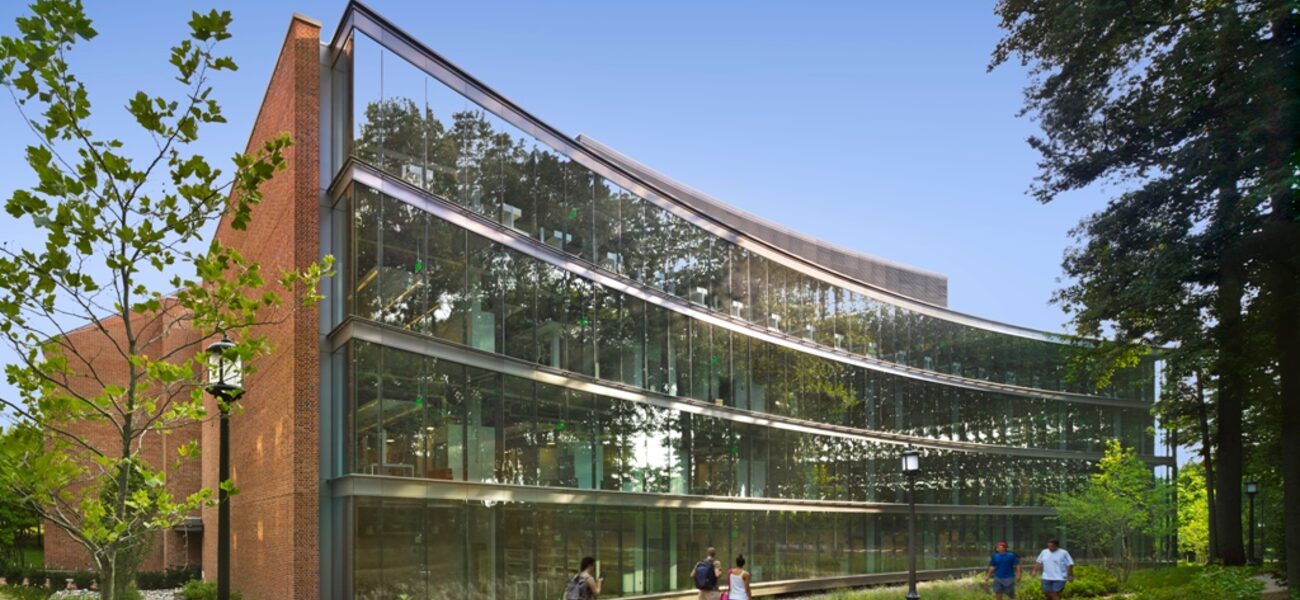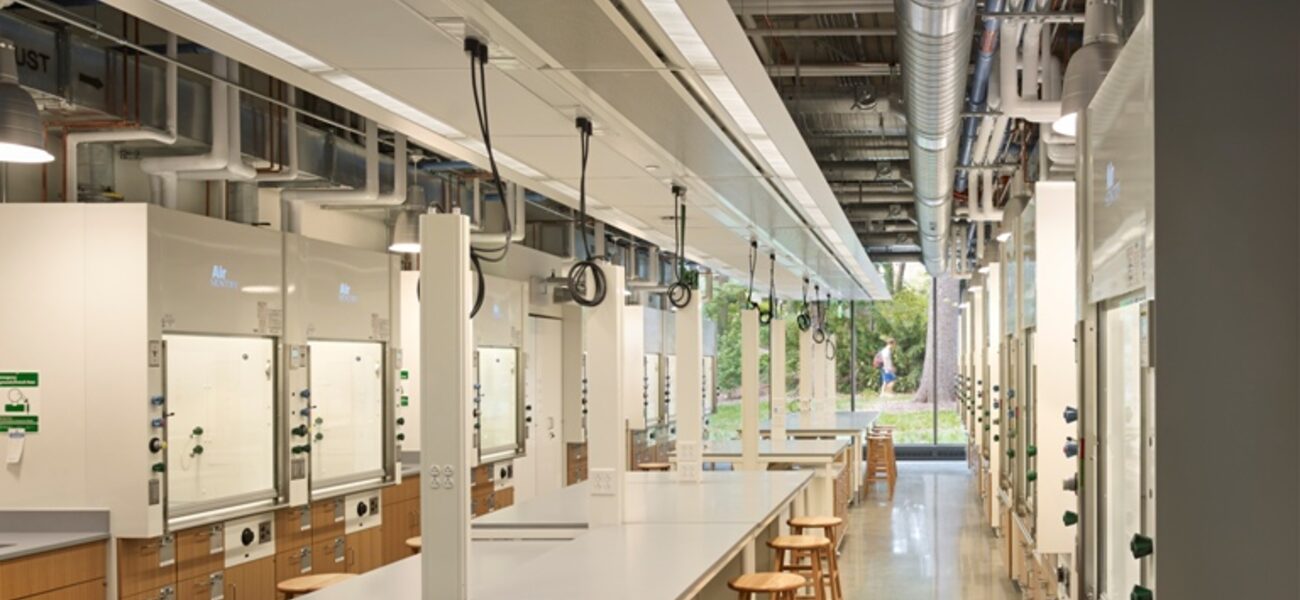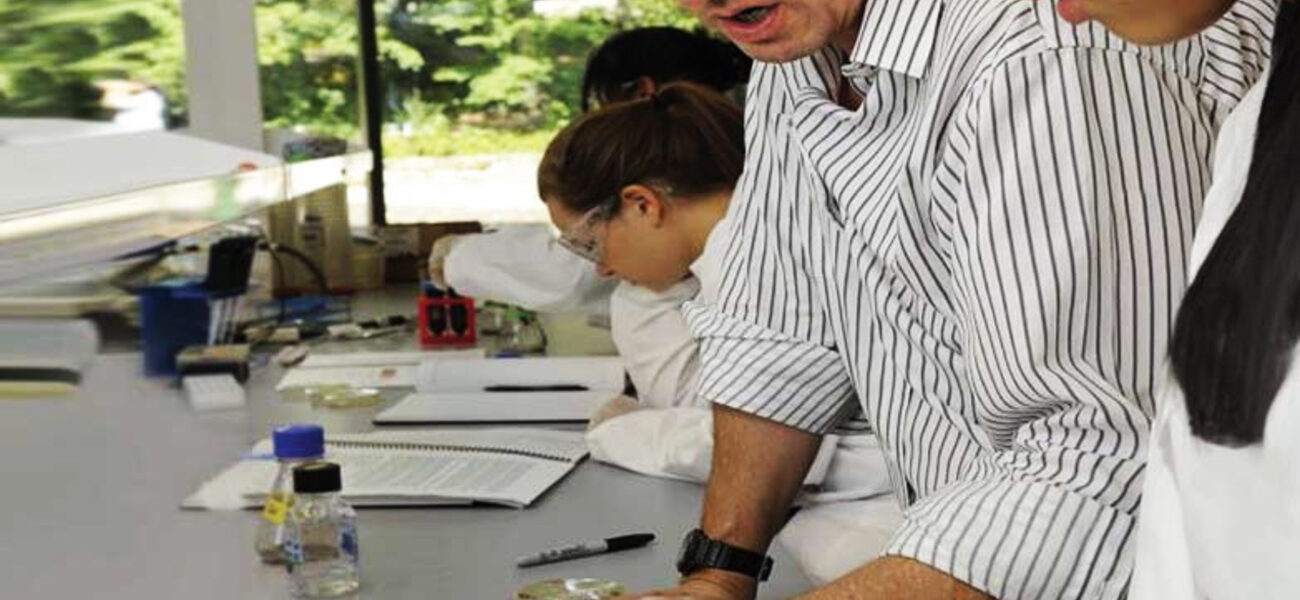Johns Hopkins University’s 105,000-sf Undergraduate Teaching Labs (UTL) replace outdated, dispersed facilities with a single building that increases collaboration across scientific disciplines and offers a new model for research and education. The visually stunning UTL collocates all teaching laboratories for the departments of biology, chemistry, neuroscience, and biophysics, with a shared instrument core. The facility also contains dedicated “project labs” that provide a platform for undergraduate students to participate in actual research.
The project labs, designed for research to be conducted over multiple semesters, is one of the facility’s most innovative features. This model supports an entirely new pedagogy: Teachers develop integrated lab modules that generate useful data as part of a greater curriculum, and undergraduate students engage in scientific discovery that could lead to new breakthroughs.
“Our concept of the project lab was two-fold,” says Martin Kajic, Johns Hopkins facilities project manager at the Krieger School of Arts and Sciences. “The first goal was to offer independent labs to upperclassmen who could take traditional projects a bit farther. If they found new results, those results could be incorporated into the lab for the next semester. The second goal was to think in terms of broad themes that could be managed by the project lab and incorporated across all the other labs.”
The four-story building houses 20 teaching labs on three floors, with seminar rooms and faculty offices on every floor, and a large lecture hall and atrium underground. The fourth floor is a biology research lab. Flexible modular layouts provide the ability to adapt curricula and lab space as needs change. Undergraduate students analyze enzymes and culture cells in the lab, exploring the principles covered in lectures. Nearly half of all undergrads attending the University’s arts and sciences and engineering schools will use the building at some point.
“We wanted to collocate all of our teaching labs to foster an interdisciplinary approach and allow for the sharing of core facilities,” says Kajic. “That required establishing a highly flexible and interchangeable lab standard with dedicated support and storage areas located outside the lab proper to allow for better circulation.”
Collocation and Shared Equipment
The four respective disciplines had been housed in four separate buildings on campus, with very little opportunity for interaction. Bringing them all together in a single space promotes interaction and education across disciplines.
“We put biochemistry and organic chemistry on the same floor,” says Kajic. “They originally said they weren’t going to have much in common. Now they’re discussing future classes or labs that could be piloted in the project lab.”
“To foster interaction, the building is shaped to provide corridor space of an irregular width that allows for casual seating in numerous areas—including outside the faculty offices—and these are heavily used,” says Travers Nelson, the University’s project manager for design and construction.
Faculty offices are located directly across from the labs where they teach, rather than on a separate floor or wing. There are also seminar rooms across the hall to accommodate intensive instruction in conjunction with work done in the labs.
The flexible open labs feature moveable benches with services provided through ceiling interface panels. A shared instrument core is located between the physical chemistry and biophysics areas, with both departments using it. Undergraduate students have the opportunity to use state-of-the-art instruments, including nuclear magnetic resonance imagining, mass spectroscopy, and high-performance liquid chromatography, for a wide variety of experiments. A computer lab is located adjacent to the equipment core, which enables data analysis as part of the instruction format.
“The equipment in the instrument core is all research-level equipment,” says Kajic. “By applying it in the labs, students gain the knowledge and experience necessary to do work in an ongoing research facility.”
Project Labs
The project labs offer different elements from each lab type, including two fume hoods, which allow for both wet and dry lab work.
“Going into this, we thought we would pilot everything in the project lab,” says Kajic. “What we’re seeing is that we don’t have to do that. We can get really specific in the project lab but, thanks to our new layout, the traditional labs are turning out to be very project-like, as well.”
The objective of the current project lab is to isolate and characterize bacteriophages—or phages—which are viruses that attack bacteria.
“We have a faculty member working with an institute to offer a freshman-only class, with no prerequisites, where they do real research,” says Kajic. “Students do the work to isolate, name, sequence, and analyze newly discovered phages, which gives them the opportunity to think like scientists and make contributions to the field of genomics.”
Changing Pedagogy
The idea is that, by having project labs in close proximity to the traditional labs, the faculty will evolve new approaches to teaching, developing modules around common areas or themes.
“It’s a bit of a process,” says Kajic. “But we are now starting to see the traditional labs act more like these project labs. For example, in biophysics, they never even had a lab. They did lab work in their research facility. Now they have students learning about genes, about the proteins that genes encode for, and what happens when something goes wrong in those genes. The proteins and data students develop will likely feed back into the professor’s research on those genes.”
Physical chemistry and biophysics professors are now lecturing together in a new course. Once a week they go into the computer lab to do computational work. There’s also a new lab course offered for freshman and sophomores who have a strong background in chemistry.
“If you’ve had lots of chemistry course work but no lab work, organic chemistry would likely be too hard for you, and intro chemistry would be too boring,” says Kajic. “There is now a lab course that fills this intermediate gap.”
The labs for this course feature six pods of 16 hoods that allow work to be easily differentiated. Other courses enabled by the UTL include applied equilibrium reactivity and an organic chemical structure and bonding course.
“They break students into groups to make a variety of metal organic framework compounds and explore their properties,” says Kajic. “Again, this is meaningful research. It’s not groundbreaking in any way, but it is being tied back to the professor’s actual research—which represents a change from the traditional cookie-cutter approach where you get your program, do the recipe, and find the result. This is truly project-type coursework. So we are starting to see real changes in our pedagogy.”
“If you create a space where connections can happen, it naturally becomes an idea incubator,” says Beverly Wendland, former biology department chair.
Nelson adds, “We now have top-flight research faculty working with our freshman students. We have students and faculty talking with each other in our commons areas. And we have active, vital, open laboratories. The results have been very gratifying.”
By Johnathon Allen
This report is based on a presentation by Kajic and Nelson at Tradeline’s College and University Science Facilities 2014 conference.


